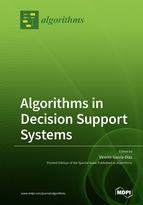Algorithms in Decision Support Systems
A special issue of Algorithms (ISSN 1999-4893). This special issue belongs to the section "Databases and Data Structures".
Deadline for manuscript submissions: closed (31 October 2020) | Viewed by 35461
Special Issue Editor
Interests: domain-specific languages; model-driven engineering; business process management; machine learning; Internet of Things and e-learning
Special Issues, Collections and Topics in MDPI journals
Special Issue Information
Dear Colleagues,
Decision support systems (DSSs) are increasingly important information systems that help to make decisions related to unstructured and semi-unstructured decision problems that do not have a simple solution from a human point of view. They are currently used in different areas, such as medical diagnosis, catastrophe avoidance, agriculture, sustainable development, sales projections, inventory organization, production design, etc. The arquitecture of a common DSS is basically composed of three main components: (1) knowledge base; (2) user interface; and (3) model to infer the decisions. Such models may be based on multiple types of algorithms, such as neural networks, logistic regression, classification trees, fuzzy logic, etc. Although there are multiple works that try to optimize the operation of DSSs, researchers are still trying to optimize their performance by refining and proposing new algorithms that normally are adapted to the set of data available for a particular domain of knowledge. Thus, the aim of this Special Issue is to enhance the state-of-the-art in this area significantly, improving the performance of DSSs in specific domains. We encourage authors across the world to submit their original and unpublished works. We have a special interest in works focusing on the topics listed below, but we are open to other works that fit the theme of the Special Issue.
Dr. Vicente García-Díaz
Guest Editor
Manuscript Submission Information
Manuscripts should be submitted online at www.mdpi.com by registering and logging in to this website. Once you are registered, click here to go to the submission form. Manuscripts can be submitted until the deadline. All submissions that pass pre-check are peer-reviewed. Accepted papers will be published continuously in the journal (as soon as accepted) and will be listed together on the special issue website. Research articles, review articles as well as short communications are invited. For planned papers, a title and short abstract (about 100 words) can be sent to the Editorial Office for announcement on this website.
Submitted manuscripts should not have been published previously, nor be under consideration for publication elsewhere (except conference proceedings papers). All manuscripts are thoroughly refereed through a single-blind peer-review process. A guide for authors and other relevant information for submission of manuscripts is available on the Instructions for Authors page. Algorithms is an international peer-reviewed open access monthly journal published by MDPI.
Please visit the Instructions for Authors page before submitting a manuscript. The Article Processing Charge (APC) for publication in this open access journal is 1600 CHF (Swiss Francs). Submitted papers should be well formatted and use good English. Authors may use MDPI's English editing service prior to publication or during author revisions.
Keywords
- Atmospheric models
- Data mining algorithms
- Deep learning algorithms
- Evolutionary algorithms
- Fuzzy logic
- Genetic algorithms
- Machine learning algorithms
- Probabilistic reasoning
- Rule-based algorithms
- Statistical methods
Related Special Issue
- Algorithms in Decision Support Systems Vol. 2 in Algorithms (8 articles)






